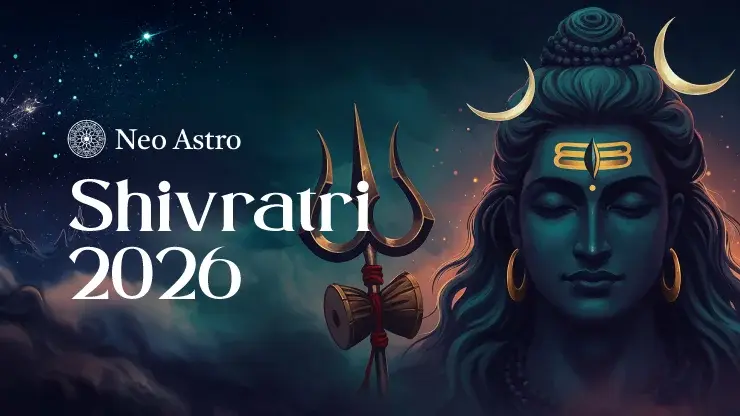Mahashivratri 2026: Find Date, Puja Muhurat & Spiritual Significance

“ॐ त्र्यंबकं यजामहे सुगंधिं पुष्टिवर्धनम्।
उर्वारुकमिव बन्धनान् मृत्योर्मुक्षीय माऽमृतात्॥”
As these sacred words echo across temples and homes, they awaken the spirit of Mahashivratri 2026, the Great Night of Lord Shiva. This is the night when faith transcends form, and countless devotees across India turn inward in devotion and silence. From the snow-laden shrines of Kedarnath to the illuminated ghats of Varanasi, the country prepares to honour the Lord who dissolves darkness and awakens consciousness.
Falling on Sunday, 15 February 2026, this time Mahashivratri holds immense spiritual and astrological importance. The planetary positions during the Krishna Paksha Chaturdashi are believed to create vibrations that support meditation, balance and renewal. As the celestial energy peaks on this divine night, one question gently stirs the heart; what insights and transformations could Mahashivratri 2026 hold for you through the wisdom of astrology? Let’s find it today!
When is Mahashivratri in 2026?
In 2026, Mahashivratri will be celebrated on Sunday, 15 February, according to the Hindu lunar calendar. The Krishna Paksha Chaturdashi Tithi of the Phalguna month (or Magha, by regional variation) begins at 5:04 pm on 15 February and concludes at 5:34 pm on 16 February (IST).
The most auspicious period for worship, known as the Nishita Kaal falls between 12:09 am and 1:01 am on 16 February. This is the deep midnight phase, regarded as the moment when Lord Shiva’s energy is most accessible to devotees. The Parana (fast-breaking) should be performed the next morning, after 6:59 am, ideally before 3:24 pm.
Many devotees begin fasting and prayers at dawn on 15 February and stay awake through the night, performing Shivratri puja during the four Prahars (phases of the night). Observing Maha shivratri in 2026 on the correct date and timing ensures the puja aligns with the planetary vibrations and the energy of the moon, strengthening both devotion and astrological harmony.
Understanding Shivratri Puja Timings & Phases of the Night
The celebration of Maha Shivaratri 2026 is structured around the four Prahars (Phases). Each of these prahars represents a step deeper into meditation and surrender, and offers a chance to honour Lord Shiva through Abhishekam, chanting, and reflection.
First Prahar (6:11 pm – 9:23 pm)
The festival begins as the sun sets. Homes and temples are lit with lamps, and the first Abhishekam starts with offerings of water, milk, and bilva leaves. It symbolises purification and preparation.
Second Prahar (9:23 pm – 12:35 am)
The night thickens with devotion. Chanting of Rudram and Shiv Chalisa fills the air. This phase reflects surrender, letting go of ego and worldly attachments.
Third Prahar (12:35 am – 3:47 am)
This phase holds the Nishita Kaal, that will start from 12:09 am to 1:01 am, and it is considered the most sacred window of the night. It is believed that Lord Shiva performs his cosmic dance, Tandava, during this time. Devotees meditate, chant, and pour Panchamrit (a mixture of milk, ghee, curd, honey, and sugar) on the Shiva Linga.
Fourth Prahar (3:47 am – 6:59 am)
As the night gives way to dawn, the final puja with Shiv Aarti is performed. It marks awakening and renewal, and the moment to invite peace and clarity into life. The fast is broken during the Parana Muhurat after sunrise.
Each phase of the night holds symbolic depth; from cleansing and letting go, to stillness and awakening. Staying awake on Mahashivratri is not just tradition; it is said to keep the body’s energy upright, promoting physical balance and mental focus. It is a truth even aligned with yogic and astrological understanding.
Maha Shivratri 2026 Puja Timings at a Glance (IST – New Delhi)
| Phase (Prahar) | Subh Muhurat | Spiritual Focus |
| First Prahar Puja | 6:11 PM – 9:23 PM (15 Feb) | Purification and preparation – entering devotion |
| Second Prahar Puja | 9:23 PM – 12:35 AM (16 Feb) | Surrender and offering – deepening meditation |
| Third Prahar Puja (Nishita Kaal) | 12:09 AM – 1:01 AM (16 Feb) | The most sacred hour – ideal for Abhishekam and chanting |
| Fourth Prahar Puja | 3:47 AM – 6:59 AM (16 Feb) | Renewal and awakening – closing the night in prayer |
| Parana (Fast Breaking) | After 6:59 AM until 3:24 PM (16 Feb) | Gratitude and completion of Mahashivratri Vrat |
Note: People who are fasting on Mahashivratri can start fasting from 15th Feb with the sunrise, and break it on the following morning, Feb 16, after sunrise and completion of the puja rituals.
Mahashivratri Significance: Insights on Why is Shivratri Celebrated?
Every year, Mahashivratri brings with it a wave of devotion and faith that touches every corner of India. The festival that has been witnessed from ages, has its stories in our sculptures. Each of them offer a glimpse into Shiva’s greatness and the deeper meaning of this night.
According to the Shiva Purana and Skanda Purana, Mahashivratri marks the divine marriage of Lord Shiva and Goddess Parvati. Their union is seen as the coming together of energy (Shakti) and consciousness (Shiva). It teaches that balance between the two is what sustains the universe. Just as Parvati’s devotion united her with Shiva, devotees believe that faith and discipline can help them find peace in their own lives.
Another beautiful story, described in the Vayu Purana, says that the reason for mahashivratri is also related to the night when Lord Shiva performed his Ananda Tandava. The cosmic dance of creation, preservation, and destruction. The sound of his damru is said to be the heartbeat of the cosmos, which shows that everything in life moves in rhythm; birth, growth, and renewal.
The Linga Purana tells yet another legend, known as the Lingodbhava story. When Brahma and Vishnu once argued about who was supreme, Lord Shiva appeared as an endless pillar of fire to show that divinity has no beginning and no end. The Shiva Linga, worshipped during Mahashivratri, symbolises this infinite form, the eternal truth beyond human understanding.
Spiritually, Mahashivratri is also called the Night of Transformation. Texts like the Padma Purana mention that during this time, the planetary positions support meditation and inner peace. People fast, stay awake, and focus their thoughts on Lord Shiva, as this helps the mind turn inward and release negative energy. Many astrologers believe that Mahashivratri 2026 will carry a strong spiritual vibration, making it an ideal time for reflection, healing, and personal growth.
Astrology View of Mahashivratri 2026
From an astrological viewpoint, Maha Shivratri 2026 is a night of alignment between the movement of celestial bodies and the human spirit. The Krishna Paksha Chaturdashi Tithi occurs when the moon’s light is at its faintest. In yogic science, this low lunar influence allows the mind to remain calm and receptive, ideal for meditation.
For those following astrology, the moon’s position during Mahashivratri connects deeply with the Ajna Chakra (third eye) that represents awareness and intuition. This is why yogis and astrologers believe that meditating during the Nishita Kaal enhances clarity and spiritual vision.
Key astrological associations for Maha Shivratri 2026:
The night promotes detachment from illusions and strengthens inner stability.
Fasting and mantra chanting purify karmic patterns.
Aligning puja with the Lagna (Ascendant) of your birth chart enhances the impact of prayers.
The mantra Om Namah Shivaya resonates with the five elements; the earth, water, fire, air, and space, bringing harmony to one’s energy field.
Many astrologers suggest that performing puja during Mahashivratri supports those seeking peace, career balance, and healing from emotional turbulence. The planetary energies are said to assist sincere intentions made on this night, turning them into karmic progress.
Shiv Ratri Puja Vidhi at Home & Fasting (Vrat) Rules & Good Practice
The night of 15 February 2026, the official Shivratri date 2026, holds immense significance. Every offering, every mantra, and every moment of silence during the Shivratri puja time carries divine energy. Here’s a simple and soulful way to observe the rituals and fast at home.
Puja Vidhi: Step-by-Step Ritual for Devotees
1. Purification and Preparation: Begin the day early with a bath. This symbolises the cleansing of body and mind. Wear light or white clothing to reflect purity. Choose a calm space facing north or east directions sacred to Lord Shiva, and keep your mind free from distraction.
2. Setting the Altar: Place a Shiva Linga or picture of Lord Shiva on a copper or brass plate. Arrange offerings such as milk, honey, ghee, curd, sugar, bilva leaves, white flowers, and fruits. Lighting a small oil lamp marks the start of your Lord Shiva Maha shivratri puja.
3. Invocation (Dhyana and Mantra): Light incense sticks, take a few deep breaths, and focus your attention on the divine form of Shiva. Chant Om Namah Shivaya 108 times with calm intention. This sacred sound aligns the heart with universal energy and prepares the atmosphere for Abhishekam.
4. Abhishekam (Holy Bathing of the Linga): Pour water, milk, or Panchamrit (a mix of milk, curd, ghee, honey, and sugar) over the Shiva Linga. While offering each element, recite the Mahamrityunjaya Mantra with devotion.
- Water symbolises peace.
- Milk represents purity.
- Honey stands for sweetness in life.
- Ghee reflects light and wisdom.
- Sugar denotes bliss and fulfilment.
This act of Abhishekam is the heart of the Shivratri puja, believed to wash away negativity and attract blessings for health and prosperity.
5. Offerings and Aarti: After the Abhishekam, gently wipe the Linga and decorate it with bilva leaves and white flowers. Offer fruits, incense, and sandalwood paste. As you perform aarti, let the flame symbolise the victory of light over ignorance. End this phase with a few minutes of silence or meditation, letting the mind rest in peace.
6. Night Vigil and Four Prahars: The night of Mahashivratri 2026 is divided into four Prahars, or quarters. Ideally, devotees perform Shivratri puja during each Prahar, aligning with the spiritual energy that changes through the night. Staying awake represents alertness and awareness, the qualities Lord Shiva embodies. If performing all four sessions isn’t possible, the Nishita Kaal, around midnight, is the most auspicious time to worship.
Fasting (Vrat) Rules and Good Practice
Fasting during Mahashivratri is a practice of self-control and surrender. It’s not meant to cause discomfort but to help the devotee focus inward.
You can choose between a nirjala vrat (without food and water), a phalahar vrat (fruits and milk), or a simple sattvic meal once during the day.
Drink water or milk if fasting without food feels difficult, maintaining hydration supports meditation.
Avoid onion, garlic, grains, and heavy or processed foods.
Keep speech minimal and spend time in chanting or reading about Lord Shiva Mahashivratri from the Shiva Purana.
Observe calmness through the night and offer your prayers during the scheduled Shivratri puja time for your location.
Break the fast during Parana, after sunrise on 16 February 2026, preferably before noon.
Remember, fasting is not about denying the body but about turning your energy inward. When the mind becomes still and the heart grows lighter, worship turns into meditation.
Conclusion
As you finish exploring the meaning and traditions of Mahashivratri 2026, it becomes clear that this sacred night is far more than a mark on the calendar. Every legend, ritual, and astrological detail shows how beautifully the festival weaves devotion with universal balance. The fasting, chanting, and meditation practised on this occasion remind us that spiritual awakening begins from within. When the auspicious Shivratri date 2026 arrives, may the blessings of Lord Shiva fill your path with strength and serenity.
For accurate Shivratri puja time, personalised rituals, and expert astrological insights, download the Neo Astro App and connect with trusted astrologers today. Har Har Mahadev!
FAQs - Mahashivratri 2026
What is the best time to perform Shivratri puja at home?

The most auspicious Shivratri puja time is during the Nishita Kaal, around 12:09 am to 1:01 am (IST) on 16 February 2026. Devotees who cannot stay awake the whole night can perform puja at this time to gain maximum spiritual benefits.
How should I prepare for the Mahashivratri fast?

Start the day early with a light meal or fruit and plenty of water. Many devotees observe a nirjala vrat (without food and water), while others choose fruit or milk fasts. Keep your mind calm, avoid distractions, and spend time chanting Om Namah Shivaya.
Can I perform Mahashivratri puja without a Shiva Linga?

Yes, you can. If you don’t have a Shiva Linga, use an image or symbol of Lord Shiva. The purity of intention matters more than the form of worship.
What is the connection between astrology and Mahashivratri 2026?

Astrologically, Maha Shivratri 2026 falls during the Krishna Paksha Chaturdashi, when planetary and lunar positions favour meditation and self-awareness. It’s said that energies during this night help balance emotions, calm the mind, and support spiritual growth.
What should I offer to Lord Shiva on Mahashivratri?

Offerings like water, milk, honey, bilva leaves, and white flowers are considered sacred. These symbolise purity, peace, and devotion, qualities Lord Shiva blesses his devotees with.
How can I get the exact puja timings for my city?

Puja timings can vary slightly by location. To know the exact Shivratri date 2026 and Shivratri puja time for your city, connect with experienced astrologers through the Neo Astro App, where you’ll receive accurate guidance and personalised rituals.
